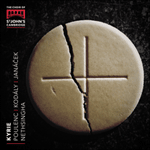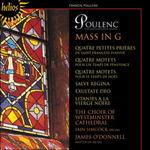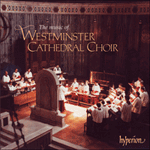
Welcome to Hyperion Records, an independent British classical label devoted to presenting high-quality recordings of music of all styles and from all periods from the twelfth century to the twenty-first.
Hyperion offers both CDs, and downloads in a number of formats. The site is also available in several languages.
Please use the dropdown buttons to set your preferred options, or use the checkbox to accept the defaults.

It is interesting that some of the musical gestures learned in his youth and through Les Six gain a seriousness in his choral works which is most refreshing: the bass line at ‘Qui tollis peccata mundi’ in the Gloria of the Messe; the frequent use of detaché chords and the whimsical nature of the Sanctus.
from notes by William McVicker © 1994
Il est intéressant de noter que certaines des techniques qu’il avait apprises dans sa jeunesse et par l’intermédiaire des Six sont utilisées dans ses œuvres chorales avec un sérieux très original: la mélodie de basse au «Qui tollis peccata mundi» dans le Gloria de la Messe; le recours fréquent à des accords détachés et le côté fantasque du Sanctus.
extrait des notes rédigées par William McVicker © 1994
Français: Madeleine Jay
Es ist interessant, daß einige der musikalischen Gesten, die er in seiner Jugend und durch Les Six erlernte, in seinen Chorwerken eine Ernsthaftigkeit erlangen, die außerordentlich erfrischend ist: die Baßzeile bei „Qui tollis peccata mundi“ im Gloria der Messe; die häufige Verwendung von detachierten Akkorden und die schrullenhafte Natur des Sanctus.
aus dem Begleittext von William McVicker © 1994
Deutsch: Anke Vogelhuber
 Poulenc, Kodály & Janáček: Kyrie Poulenc, Kodály & Janáček: KyrieThree twentieth-century choral masterpieces in new recordings from one of Cambridge's most prestigious colleges. The choir's previous album (of works by Jonathan Harvey) received the 2017 BBC Music Magazine Choral Award.» More |
 Poulenc: Mass & Motets Poulenc: Mass & MotetsA generous selection of Poulenc’s wonderful and varied liturgical works, including some of Poulenc’s most beautiful and tender music as well as the famous Mass in G.» More |
 The music of Westminster Cathedral Choir The music of Westminster Cathedral Choir'A wonderful programme. Westminster Cathedral Choir excite, enthral and electrify under both James O'Donnell and his predecessor David Hill. It would make an ideal gift for any lover of the tradition' (Cathedral Music) 'Bargain of the month' ( ... » More |

